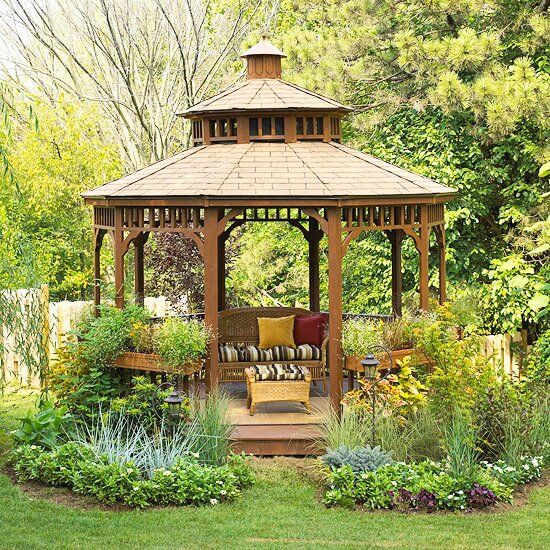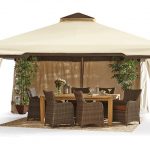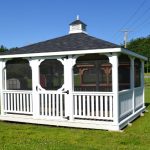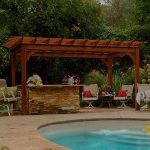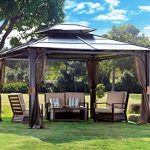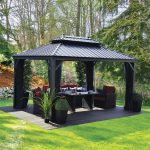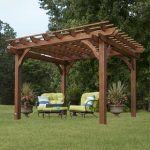Gazebos are a timeless and elegant addition to any outdoor space, whether in a backyard, garden, or patio. They provide a beautiful and functional space for relaxing, dining, entertaining, and enjoying the outdoors in comfort and style. If you are considering adding a gazebo to your outdoor space but are unsure where to start, fear not! This ultimate guide to gazebos will cover everything you need to know about selecting, installing, and maintaining a gazebo.
Types of Gazebos
There are several types of gazebos to choose from, each offering unique design elements and features to suit different preferences and needs. Some popular types of gazebos include:
– Traditional Gazebos: These are the classic octagonal or hexagonal-shaped structures with open sides and a domed or sloped roof. Traditional gazebos are versatile and can be customized with various materials, such as wood, metal, or vinyl. – Pergola Gazebos: These gazebos have an open-roof design, usually with a lattice or trellis roof for climbing vines and plants. Pergola gazebos provide partial shade and a natural, organic feel to outdoor spaces. – Pop-up Gazebos: These portable and easy-to-assemble gazebos are perfect for temporary use at events, picnics, or camping trips. Pop-up gazebos are lightweight, collapsible, and come in various sizes and styles. – Screened Gazebos: These gazebos have screened-in walls to keep bugs and insects out while still allowing for airflow and visibility. Screened gazebos are ideal for areas with high insect activity or for those looking for added privacy.
Factors to Consider When Choosing a Gazebo
When selecting a gazebo for your outdoor space, consider the following factors to ensure that it meets your needs and complements your existing landscape and decor:
– Size: Determine the size of the gazebo based on the available space in your outdoor area and how you plan to use it. Consider factors such as seating capacity, table size, and any additional features you want to include. – Material: Gazebos are available in various materials, such as wood, metal, vinyl, and fabric. Choose a material that fits the style of your outdoor space, requires minimal maintenance, and withstands the weather conditions in your area. – Style: Select a gazebo style that matches the architectural design of your home and complements the aesthetic of your outdoor space. Consider the shape, roof design, and details, such as columns, trim, and decorative elements. – Functionality: Think about how you will use the gazebo and what features are essential for your needs. Consider factors such as shade coverage, ventilation, lighting, privacy, and accessibility. – Budget: Set a budget for your gazebo project and explore various options within your price range. Consider the cost of materials, labor, accessories, and any additional features you want to include.
Installing and Maintaining a Gazebo
Once you have selected a gazebo that meets your needs and preferences, it’s time to install and maintain it to ensure years of enjoyment and use. Follow these tips for a successful gazebo installation and long-term maintenance:
– Site Preparation: Choose a flat and stable location for your gazebo that is free from obstructions, such as trees, shrubs, or utility lines. Prepare the site by removing any vegetation, leveling the ground, and ensuring proper drainage. – Assembly: Follow the manufacturer’s instructions and guidelines for assembling your gazebo. Use the recommended tools, hardware, and materials to ensure a secure and stable structure. Consider enlisting the help of a professional installer for complex or custom gazebos. – Foundation: Depending on the gazebo style and material, you may need to install a foundation, such as a concrete pad, gravel base, or deck platform, to support and stabilize the structure. Consult with a contractor or structural engineer for guidance on the foundation type and size. – Roof and Canopy: Ensure that the roof of your gazebo is properly constructed and sealed to protect against leaks, water damage, and UV exposure. Consider adding a canopy or curtains for additional shade, privacy, and weather protection. – Maintenance: Regularly inspect and maintain your gazebo to keep it in good condition and prevent damage from weather, pests, and wear and tear. Clean the gazebo structure, roof, and accessories regularly with mild soap and water, and inspect for any signs of damage or decay. – Repairs: Address any repairs or maintenance issues promptly to prevent further damage and prolong the lifespan of your gazebo. Repair loose or broken components, replace damaged materials, and refinish or repaint as needed to keep your gazebo looking and functioning like new.
In conclusion, gazebos are a beautiful and functional addition to any outdoor space, providing a relaxing and stylish shelter for enjoying the outdoors. By considering the type, size, material, style, and functionality of a gazebo, and following proper installation and maintenance practices, you can create a stunning and durable outdoor oasis for years to come. Whether you choose a traditional, pergola, pop-up, or screened gazebo, you can enjoy the benefits of shade, comfort, and beauty in your outdoor living space. With this ultimate guide to gazebos, you have everything you need to know to make an informed decision and create your perfect outdoor retreat.
 goodworksfurniture Decoration and home design ideas
goodworksfurniture Decoration and home design ideas
